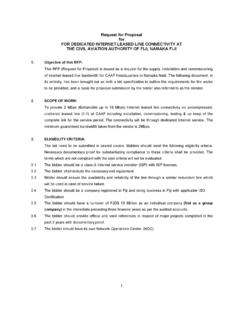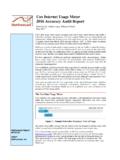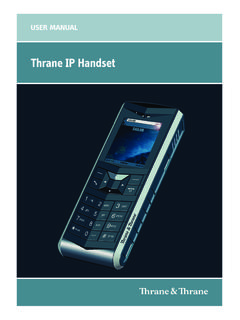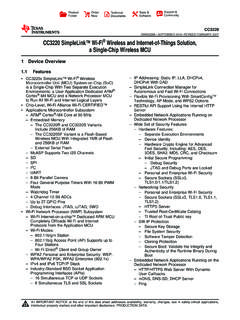Transcription of Internet Content Adaptation Protocol (ICAP)
1 Network Appliance 1 of 13 Internet Content Adaptation Protocol (ICAP)Network ApplianceVersion Scope/Executive Summary2. Introduction3. ICAP Architecture4. NetCacheTM Deployment in Support of ICAP5. ConclusionGlossaryReferences 1. Scope/Executive SummaryThis document provides a brief introduction to ICAP, explains what ICAP means to the future ofInternet Content handling, and discusses how NetCache is ideally suited to handle these ICAP enabled value-added services. The following section introduces ICAP, shows why it is needed,and how it can be leveraged to standardize and modularize Internet Content manipulation( Content vectoring).2. IntroductionICAP was formally introduced in December 1999 by the ICAP Forum ( ). TheICAP Forum is a coalition of Internet businesses covering a wide array of services; includinghardware and software providers, Content distribution providers, application service providers,advertising institutions, hosting providers, broadband providers, etc.
2 These members arededicated to making the future of the Internet accessible (and scalable) to the evolving value-added services (services added onto plain old Internet access) business. This forum was co-founded (and still co-chaired) by Network Appliance and Akamai Technologies. What are theNetwork Appliance 2 of 13goals of the ICAP Forum? Make Content more flexible for end users. Provide a common, open standard for edge-based appliance communication to handlethese value-added services. Off-load resource-intensive APIs and other services from Web site servers to Protocol needs to: Be simple. Be scalable. Use existing infrastructure. Be modular in its service. That is, services must be able to be added and subtractedwithout affecting the intervening architecture or its performance. Use existing communication methods and standards. Provide resource savings by leveraging edge is a Protocol designed to off-load specific Internet -based Content to dedicated servers,thereby freeing up resources and standardizing the way in which features are implemented.
3 Forexample, a server that handles only language translation is inherently more efficient than anystandard Web server performing many additional tasks. ICAP concentrates on leveraging edge-based devices (proxies and caches) to help deliver value-added services. At the core of thisprocess is a cache that will proxy all client transactions and will process them throughICAP/Web servers. These ICAP servers are focused on a specific function, for example, adinsertion, virus scanning, Content translation, language translation, or Content filtering. Off-loading value-added services from Web servers to ICAP servers allows those same web serversto be scaled according to raw HTTP throughput versus having to handle these extra in its most basic form is a "lightweight" HTTP based remote procedure call Protocol . Inother words, ICAP allows its clients to pass HTTP based (HTML) messages ( Content ) to ICAP servers for Adaptation . Adaptation refers to performing the particular value added service( Content manipulation) for the associated client What Initiated ICAP?
4 The problem with the Internet , in its early stage of growth, is the ability to scale the traffic,bandwidth, services, access, etc. If it s possible to do something over the Internet , odds are itwon t scale to meet the demand. This certainly is the case for value-added services. Theseservices provide real and necessary applications for clients. Unfortunately, these value-addedservices consume resources such as bandwidth and server processing time, and thereforeNetwork Appliance 3 of 13introduce more delay into the already "click and wait" s services almost exclusively run on proprietary APIs that are custom built for theprovider s particular business application. These APIs are often unreliable because they aren tdesigned to scale with the hardware as the "e-commerce" companies Web business grows. Inaddition, these APIs can be very costly to change and any new service would require anadditional Servers.
5 Today s laundry list of services that are offered can overload and slowdown a site s access and transactions to a point of losing business. These value-added serviceseach tend to run through a separate software application, causing servers to bog down. Theservers are not appliances designed from the ground up to run these APIs, but they are asked tohandle these services on top of what they already are asked to do. Such services include access,authentication, customer information database, e-commerce, language translation, contentfiltering virus scanning, ad insertion, etc., all leading to higher latency and reduced Much Overhead. In addition to bogging down servers, the value-added services causeadditional latency risks by clogging bandwidth and the network highways that must carry all Device Support. Supporting many of the same Web services for wireless customersthat are available for the PC user, such as synchronizing e-mail between all your latest devices,has become a necessary service.
6 With the proliferation of wireless devices (expansion of thewireless market), there exists too many communication varieties (standards) that must be adaptedfor communication into and out of the Internet . Adding to this problem is the relatively narrowtransmission rate ( on average). The solution has been a collection of network devicesthat include transmission towers, wireless gateways, proxy servers, and additional applicationsrunning on top of origin servers ( Content ) that are adapted to scale down their Content andservices for the small amount of data these devices can SolutionWhat is the answer to the above problems? ICAP solves the above problems with its openarchitecture and ease of the modular development Benefits of ICAP ICAP leverages existing equipment available today. In fact, if NetCache (a proxyappliance) proxies are already installed, then no new equipment is necessary, with theexception of the ICAP servers. ICAP is HTTP based, enabling access through security barriers that only allow port 80traffic.
7 Therefore, no security changes to the existing network are likely. ICAP is an open Protocol and allows any server or application provider to implement is easy to implement since it leverages Apache code. ISPs and enterprises can thenchoose the appropriate value-added application Appliance 4 of 13 ICAP can also collect client interest information for use in targeting more focusedadvertising toward these individuals. ICAP off-loads these value-added services to ICAP servers, freeing up the resources ofthe Web servers. This reduces the access times on these sites. ICAP simplifies the implementation, reliability, and scalability of value-added leverages edge device and infrastructure to deliver edge-based value-addedservices that require Content What Do All These Benefits Give You? Able to implement services quickly Able to outsource a service completely Improve user satisfaction Target ads better and cheaper Improve management, security, and control of Content Optimize site scalability, reliability, and performance Derive new revenue Example ICAP Virus ScanningThis is the ability to perform "on-the-fly" virus checks of new Content and provide cachedcontent that was previously Method: Virus scanning was always left to the receiving network (or PC) toaccomplish, and every object has the potential to be scanned many times, causing a waste ofresources.
8 There is no historical "on-the-fly" method for virus scanning prior to are the benefits under ICAP? ICAP s "on-the-fly" virus scanning allows previouslyscanned (and unaffected) objects to be cached and provided virus Markup Language Translation (PDAs/Cell Phones).This is the ability to allow non-HTML devices (such as cellular phones) to talk to HTML devicessuch as PCs and vice versa. This is essentially a WAP/XML/HTML translation Method: Deploy gateways specific to translating the particular device s language toHTML and back. This method involves funneling all transmissions into a single set of gatewaysas a point of presence to the Appliance 5 of 13 What are the benefits under ICAP? Under ICAP, point-of-presence entry can reside anywhere atransmission point can tap into the network. A cache can handle all client requests throughredirects to translation ICAP servers and maintain cached copies of multiple formatted objectsfor faster response to the Advertising InsertionThis is the ability to insert ads into Web pages or to spawn new pages based on customerpreferences/history/location when a customer performs a request from a Web site such as asearch Method: The historical method for ad insertion was based on either the origin Website s ISP, the hosting provider, or the site itself signing up for direct are the benefits under ICAP?
9 Ad insertion will be more focused to individuals based onoriginating IP address of the proxy server, customer-entered keywords (for example, typing inStar Wars may get the customer a direct ad from Amazon or a local bookshop), or customercollected information (profiling). Profiling can be very specific. For example, an individualbrowsing Scientific American may click on a car ad and later click on a car ad in NationalGeographic. Based on what type of car ad was queried by the client, a specific ad could betargeted at the client for a local car dealership that has that car for sale and it s current price. Geography (IP address/zip code) Search engine Keyword Adaptation Customer Human Language TranslationThis is the ability to translate formatted HTML-tagged Content from one language to another (forexample, English to Japanese).Historical Method: Expansive and resource-hungry APIs running typically on client machines orWeb servers. Most of these services are manual and are the benefits under ICAP?
10 Under ICAP, certain originating requests will by geographyor direct input be translated by ICAP servers via redirection from proxy Content FilteringThis is the ability to redirect an unauthorized or restricted request to another Method: Performed by the proxy server via manually entered information ordownloaded (subscribed database) from a site-list filtering reseller (for example, smart filter).What are the benefits under ICAP? Under ICAP, the Content filtering is more extensible from aNetwork Appliance 6 of 13customer perspective. Now dynamic Content can be filtered and both Content filtering and themanagement of the service can be out-sourced. In addition, the filtering (ICAP) servers can belocated remotely from a customer s Data CompressionThis is the ability to Compress HTML pages or objects from an origin Method: No HTML compression and compression accomplished manually forembedded are the benefits under ICAP?






